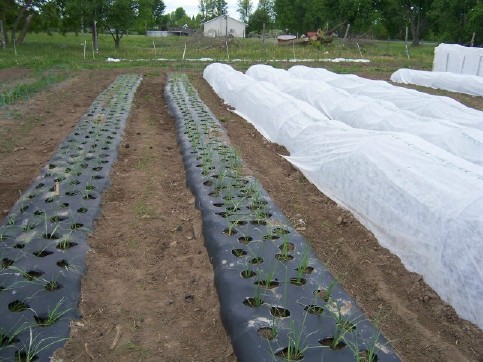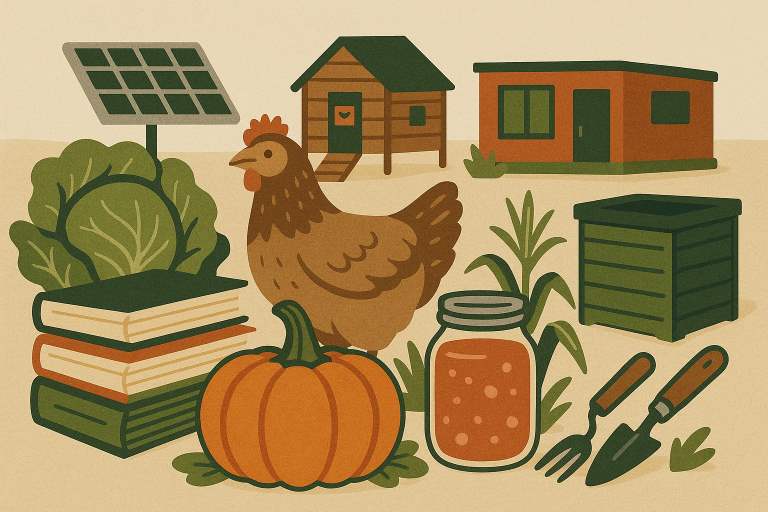Natural Garden Pest Control For The Market Grower
 Floating row cover is a passive and preventative means of natural garden pest control
Floating row cover is a passive and preventative means of natural garden pest controlOne of the realities of
gardening is, sooner or later, you will have to deal with bugs. The good
news is, you can minimize bug damage while also minimizing
negative impacts on other life forms and the environment. This article explains the natural garden pest control methods we've used on the farm for the last 20 years or so.
These suggestions are presented starting with the least potentially harmful; we recommend you start with passive and preventative measures before trying other solutions.
Important Safety Notice: while many 'organic' bug sprays are advertised as being non-toxic to people and animals, we still recommend caution when using them. Wear gloves, goggles, and a mask when using any spray other than plain water (or soap and water). Cover up with a coverall as well. And as always, keep any sprays well away from children and pets, preferably under lock and key.
Natural Garden Pest Control Starts With Good Cultural Practices
Carefully Curated Resources For The Homesteader and Prudent Property Owner
The world seems to be a little unsettled these days. I'm always looking for ways to make New Terra Farm more self-sufficient and productive.
Here's a few of the best ways I've found to make self-sufficiency happen. Useful Homesteader Resources
Start right with healthy soil and good gardening practices. The organic gardener's number one defense against pests is following good cultural practices. This means:
- maintain adequate soil fertility and organic matter by adding aged manure or compost or other soil amendments
- maintain a steady supply of moisture to the soil
- rotate crops to prevent build-up of pests
- clean up garden waste, don't give bugs a place to overwinter
Healthy, unstressed plants are more resistant to bugs and will survive weed pressure better as well. Apply as much compost as you can get your hands on, and to use drip or micro-sprinkler irrigation to supply moisture consistently to your soil. Use a rain gauge and test soil moisture regularly.
A crop rotation plan avoids the build-up of pests and helps to maintain garden fertility. For example in my Survival Garden book:
- Potatoes follow beans, sweet potatoes follow squash in rotation;
- Onions, carrots, beets can follow squash;
- Tomatoes and peppers follow beans
- Peas follow tomatoes and peppers
- Beans can follow the root crops
We took a 'short-cut' in cleaning up garden waste, composting, and fertilizing the garden by rotating our pigs and meat birds through our garden area. During the season we toss garden waste to the animal clean up crew. After the season we fence them into garden areas we want them to clean up.

The consumer demand for fresh local organic food has never been higher. Bad news on the supply chain is good news for local growers.
Get my free Organic Market Gardener Start-up Guide and see if this is the right time to launch your CSA market garden business.
An Ounce of Prevention
Prevention is your first choice in organic pest control; a little planning and labour upfront will save you work later in the garden.
Preventative and passive measures include using physical barriers to insects such as row cover and cloches, mulch to suppress weeds and retain soil moisture, and sticky traps to control pests such as whitefly.
It also includes special growing techniques such as companion planting to deter pests and support plant growth, and close planting (in wide rows or raised beds) to shade out weeds. Using these methods is just a matter of preparation and planning; we do all these things in our gardens.
At it's largest, our market garden used about 1/2-mile of row cover . It keeps the bugs out and also lets us get plants in the garden a little earlier. We use row cover on all our brassicas, our alliums (onion, leeks, garlic) and the cucurbits - cukes and squash. In the case of the latter, we leave row cover in place until the plants are well flowered. Since cucumber beetles emerge in mid-late spring, this beats their attempts at predation.
Grow Wild
We mow around our garden so the electric fence we use to keep out larger pests doesn't ground out. But we also keep a couple 'wild strips' growing across the garden to provide a habitat for the best natural garden pest control - predatory insects and birds.
The wildflowers also encourage pollinators so it's a win-win for garden health.
 The electric fence keeps out the bad guys and the wild patches attracts the good guys.
The electric fence keeps out the bad guys and the wild patches attracts the good guys.When the Solution is a Solution
Spraying insecticidal solutions starts with the least-toxic choice, plain water. A strong spray of water can dislodge many pests including aphids and spider mites.
Homemade insecticidal soaps can be made by creating a solution of 4-5 tablespoons of dish soap or liquid hand soap to a gallon of water. This spray will actually kill many insects if it comes in direct contact with them. The soap, naturally, is non-toxic to people or pets. If you use dish soap, rinse your plants off with plain water about an hour after spraying.
Other homemade mixtures include hot-pepper sprays, and garlic sprays. Dice up some hot peppers or garlic, pour boiling water over them, and let sit for an hour. Then strain the liquid into a container and cover for storage.
These
solutions use household ingredients and are comparatively
safe.
DE and BT - OMG!
Use these products with care and follow appropriate safety precautions.
Diatomaceous Earth (DE) is not actually a pesticide; it works by physical action. It is non-toxic and in fact can be consumed (food grade only) by humans.
Diatomaceous earth is the remains of microscopic one-celled plants (phytoplankton) called diatoms that lived in the oceans. When diatomaceous earth comes in contact with insects, the sharp edges lacerate the bugs waxy exoskeleton and the diatomaceous earth absorbs body fluids, causing death from dehydration. Note: use only food grade DE in your garden.
Bacillus thuringiensis (BT) is a mostly non-toxic control for pest caterpillars such as cabbage loopers, coddling moth larvae, cabbageworms, and tomato hornworms. It is harmless to people and animals, but don't spray indiscriminately as it will also kill 'good' caterpillars such as those of the monarch butterfly.
Use These With Caution
Use these plant-based products with caution.
Pyrethrins. These products have active ingredients extracted from the pyrethrum or painted daisy. Note: 'pyrethroids' are synthetic and much more toxic; check your labels to make sure which product you are using. Pyrethrins will kill many chewing and sucking insects.
Neem. Neem oil is used as a miticide, insecticide, fungicide, nematacide, and insect repellent. It is considered almost non-toxic to mammals and is bio-degradable. It is thought to be milder on beneficial insects than many botanicals, while controlling many insect pests. Pure unrefined Neem oil is usually mixed with water and a little liquid soap (to emulsify the oil) before spraying on plants.
Rotenone. This is a plant-based slow-acting toxin. It kills most beetles and insects with chewing mouth parts. It is toxic to birds, fish and beneficial insects, and requires at least a 2 week wait period after last application to plants used for food. We do not use rotenone in our gardens, and don't recommend it.
Observation then Action
Its been said 'the best fertilizer is the footprints of the farmer'; I take this to mean that spending time in your garden, and observing what's going on, will result in healthier plants (and a happier gardener).
Similarly, natural garden pest control starts with observation. Spend some of your daily garden time in a bug hunt. Buy a good book on garden bugs - like this one - and learn to recognize the 'goodies' from the 'baddies'; this is a good activity to do with your kids, too.
If you are in your garden every day, you will be able to recognize problems while they are still small enough to handle with relatively benign measures. You will probably observe (as we have) that bugs seem attracted to plants that are sickly or stressed. And this will inspire you to provide the healthiest environment you can for your plants.
Got questions to ask, stories to tell?
Share your organic market gardening question, or comment, or story.
- Home
- Market Gardening
- Natural Garden Pest Control
Recent Articles
-
Farm grown reviews of products recommended by New Terra Farm
Dec 04, 25 06:26 AM
Find great farm and garden products in my farm grown reviews -
Best Chicken Coop and Accessories for Small Farms and Homesteads
Nov 30, 25 09:18 AM
Looking for the best chicken coop? Here are the top coops, accessories, nest boxes, and gear to build a safe, productive poultry setup. -
Community Supported Agriculture Marketing Ideas To Sell Out The Season
Nov 05, 25 05:18 AM
Authentic Community Supported Agriculture marketing ideas to grow loyalty, boost sign-ups, and sell out your CSA every year




